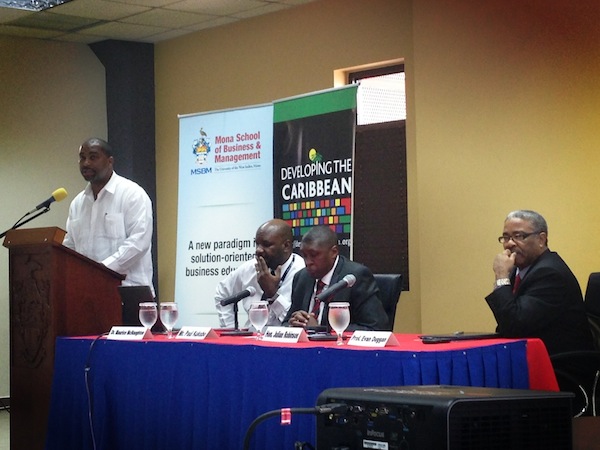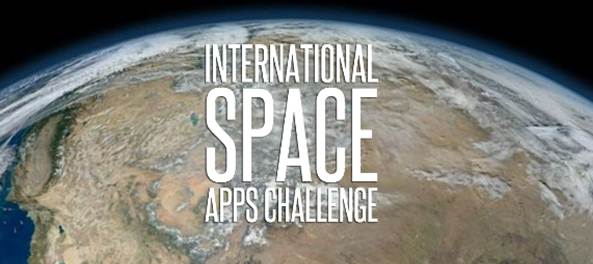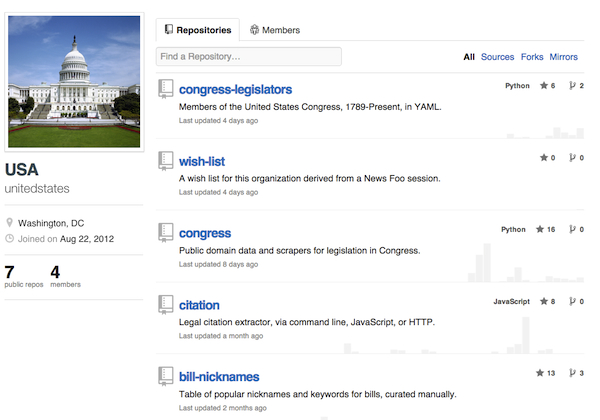- Killer App for Wearables (Fortune) — While many corporations are still waiting to see what the “killer app” for wearables is, Disney invented one. The company launched the RFID-enabled MagicBands just over a year ago. Since then, they’ve given out more than 9 million of them. Disney says 75% of MagicBand users engage with the “experience”—a website called MyMagic+—before their visit to the park. Online, they can connect their wristband to a credit card, book fast passes (which let you reserve up to three rides without having to wait in line), and even order food ahead of time. […] Already, Disney says, MagicBands have led to increased spending at the park.
- USA Govt Depts Progress on Open Data Policy (labs.data.gov) — nice dashboard, but who will be watching it and what squeeze will they apply?
- globalnamedata — We have collected birth record data from the United States and the United Kingdom across a number of years for all births in the two countries and are releasing the collected and cleaned up data here. We have also generated a simple gender classifier based on incidence of gender by name.
- geogig — an open source tool that draws inspiration from Git, but adapts its core concepts to handle distributed versioning of geospatial data.
"Gov 2.0" entries


Four short links: 1 January 2015
Wearables Killer App, Open Government Data, Gender From Name, and DVCS for Geodata


Four short links: 29 August 2014
Delivery Drones, Database Readings, Digital Govt, and GitHub Reviews
- Inside Google’s Secret Drone Delivery Program (The Atlantic) — passed proof-of-concept in Western Australia, two years into development.
- Readings in Databases — A list of papers essential to understanding databases and building new data systems. (via Hacker News)
- Todd Park Recruiting for Govt Digital Corps (Wired) — “America needs you!” he said to the crowd. “Not a year from now! But Right. The. Fuck. Now!”
- Review Ninja — a lightweight code review tool that works with GitHub, providing a more structured way to use pull requests for code review. ReviewNinja dispenses with elaborate voting systems, and supports hassle-free committing and merging for acceptable changes.


Four short links: 14 June 2014
UK Gov 2.0, Remote Work, Git + App Engine, and Amazon Sells 3D Printer Goodies
- How Geeks Opened up the UK Government (Guardian) — excellent video introduction to how the UK is transforming its civil service to digital delivery. Most powerful moment for me was scrolling through various depts’ web sites and seeing consistent visual design.
- Tools for Working Remotely — Braid’s set of tools (Trello, Hackpad, Slingshot, etc.) for remote software teams.
- Git Push to Deploy on Google App Engine — Enabling this feature will create a remote Git repository for your application’s source code. Pushing your application’s source code to this repository will simultaneously archive the latest the version of the code and deploy it to the App Engine platform.
- Amazon’s 3D Printer Store — printers and supplies. Deeply underwhelming moment of it arriving on the mainstream.

Sprinting toward the future of Jamaica
Open data is fundamental to democratic governance and development, say Jamaican officials and academics.
Creating the conditions for startups to form is now a policy imperative for governments around the world, as Julian Jay Robinson, minister of state in Jamaica’s Ministry of Science, Technology, Energy and Mining, reminded the attendees at the “Developing the Caribbean” conference last week in Kingston, Jamaica.

Robinson said Jamaica is working on deploying wireless broadband access, securing networks and stimulating tech entrepreneurship around the island, a set of priorities that would have sounded of the moment in Washington, Paris, Hong Kong or Bangalore. He also described open access and open data as fundamental parts of democratic governance, explicitly aligning the release of public data with economic development and anti-corruption efforts. Robinson also pledged to help ensure that Jamaica’s open data efforts would be successful, offering a key ally within government to members of civil society.
The interest in adding technical ability and capacity around the Caribbean was sparked by other efforts around the world, particularly Kenya’s open government data efforts. That’s what led the organizers to invite Paul Kukubo to speak about Kenya’s experience, which Robinson noted might be more relevant to Jamaica than that of the global north. Read more…


Four short links: 4 April 2013
Bootstrap Fun, Digital Public Library, Snake Robots, and Aboriginal Data
- geo-bootstrap — Twitter Bootstrap fork that looks like a classic geocities page. Because. (via Narciso Jaramillo)
- Digital Public Library of America — public libraries sharing full text and metadata for scans, coordinating digitisation, maximum reuse. See The Verge piece. (via Dan Cohen)
- Snake Robots — I don’t think this is a joke. The snake robot’s versatile abilities make it a useful tool for reaching locations or viewpoints that humans or other equipment cannot. The robots are able to climb to a high vantage point, maneuver through a variety of terrains, and fit through tight spaces like fences or pipes. These abilities can be useful for scouting and reconnaissance applications in either urban or natural environments. Watch the video, the nightmares will haunt you. (via Aaron Straup Cope)
- The Power of Data in Aboriginal Hands (PDF) — critique of government statistical data gathering of Aboriginal populations. That ABS [Australian Bureau of Statistics] survey is designed to assist governments, commentators or academics who want to construct policies that shape our lives or encourage a one-sided public discourse about us and our position in the Australian nation. The survey does not provide information that Indigenous people can use to advance our position because the data is aggregated at the national or state level or within the broad ABS categories of very remote, remote, regional or urban Australia. These categories are constructed in the imagination of the Australian nation state. They are not geographic, social or cultural spaces that have relevance to Aboriginal people. […] The Australian nation’s foundation document of 1901 explicitly excluded Indigenous people from being counted in the national census. That provision in the constitution, combined with Section 51, sub section 26, which empowered the Commonwealth to make special laws for ‘the people of any race, other than the Aboriginal race in any State’ was an unambiguous and defining statement about Australian nation building. The Founding Fathers mandated the federated governments of Australia to oversee the disappearance of Aboriginal people in Australia.

NASA launches second International Space Apps Challenge
In 2013, developers will once again boldly contribute code to projects where their code has never gone before.
From April 20 to April 21, on Earth Day, the second international Space Apps Challenge will invite developers on all seven continents to the bridge to contribute code to NASA projects.
Given longstanding concerns about the sustainability of apps contests, I was curious about NASA’s thinking behind launching this challenge. When I asked NASA’s open government team about the work, I immediately heard back from Nick Skytland (@Skytland), who heads up NASA’s open innovation team.
“The International Space Apps Challenge was a different approach from other federal government ‘app contests’ held before,” replied Skytland, via email.
“Instead of incentivizing technology development through open data and a prize purse, we sought to create a unique platform for international technological cooperation though a weekend-long event hosted in multiple locations across the world. We didn’t just focus on developing software apps, but actually included open hardware, citizen science, and data visualization as well.”
Aspects of that answer will please many open data advocates, like Clay Johnson or David Eaves. When Eaves recently looked at apps contests, in the context of his work on Open Data Day (coming up on February 23rd), he emphasized the importance of events that build community and applications that meet the needs of citizens or respond to business demand.
The rest of my email interview with Skytland follows. Read more…

The United States (Code) is on Github
Open government coders collaborate to liberate legislative data from Congress.
When Congress launched Congress.gov in beta, they didn’t open the data. This fall, a trio of open government developers took it upon themselves to do what custodians of the U.S. Code and laws in the Library of Congress could have done years ago: published data and scrapers for legislation in Congress from THOMAS.gov in the public domain. The data at github.com/unitedstates is published using an “unlicense” and updated nightly. Credit for releasing this data to the public goes to Sunlight Foundation developer Eric Mill, GovTrack.us founder Josh Tauberer and New York Times developer Derek Willis.
“It would be fantastic if the relevant bodies published this data themselves and made these datasets and scrapers unnecessary,” said Mill, in an email interview. “It would increase the information’s accuracy and timeliness, and probably its breadth. It would certainly save us a lot of work! Until that time, I hope that our approach to this data, based on the joint experience of developers who have each worked with it for years, can model to government what developers who aim to serve the public are actually looking for online.”
If the People’s House is going to become a platform for the people, it will need to release its data to the people. If Congressional leaders want THOMAS.gov to be a platform for members of Congress, legislative staff, civic developers and media, the Library of Congress will need to release structured legislative data. THOMAS is also not updated in real-time, which means that there will continue to be a lag between a bill’s introduction and the nation’s ability to read the bill before a vote. Read more…

Investigating data journalism
Scraping together the best tools, techniques and tactics of the data journalism trade.
Great journalism has always been based on adding context, clarity and compelling storytelling to facts. While the tools have improved, the art is the same: explaining the who, what, where, when and why behind the story. The explosion of data, however, provides new opportunities to think about reporting, analysis and publishing stories.
As you may know, there’s already a Data Journalism Handbook to help journalists get started. (I contributed some commentary to it). Over the next month, I’m going to be investigating the best data journalism tools currently in use and the data-driven business models that are working for news startups. We’ll then publish a report that shares those insights and combines them with our profiles of data journalists.
Why dig deeper? Getting to the heart of what’s hype and what’s actually new and noteworthy is worth doing. I’d like to know, for instance, whether tutorials specifically designed for journalists can be useful, as Joe Brockmeier suggested at ReadWrite. On a broader scale, how many data journalists are working today? How many will be needed? What are the primary tools they rely upon now? What will they need in 2013? Who are the leaders or primary drivers in the area? What are the most notable projects? What organizations are embracing data journalism, and why?
This isn’t a new interest for me, but it’s one I’d like to found in more research. When I was offered an opportunity to give a talk at the second International Open Government Data Conference at the World Bank this July, I chose to talk about open data journalism and invited practitioners on stage to share what they do. If you watch the talk and the ensuing discussion in the video below, you’ll pick up great insight from the work of the Sunlight Foundation, the experience of Homicide Watch and why the World Bank is focused on open data journalism in developing countries.

Charging up: Networking resources and recovery after Hurricane Sandy
In the wake of a devastating storm, here's how you can volunteer to help those affected.
Even though the direct danger from Hurricane Sandy has passed, lower Manhattan and many parts of Connecticut and New Jersey remain a disaster zone, with millions of people still without power, reduced access to food and gas, and widespread damage from flooding. As of yesterday, according to reports from Wall Street Journal, thousands of residents remain in high-rise buildings with no water, power or heat.
E-government services are in heavy demand, from registering for disaster aid to finding resources, like those offered by the Office of the New York City Advocate. People who need to find shelter can use the Red Cross shelter app. FEMA has set up a dedicated landing page for Hurricane Sandy and a direct means to apply for disaster assistance:
If you’ve been affected by #Sandy apply for assistance online at disasterassistance.gov or call 1-800-621-FEMA(3362) #CT #NY #NJ
— FEMA (@fema) November 2, 2012
Public officials have embraced social media during the disaster as never before, sharing information about where to find help.
No power and diminished wireless capacity, however, mean that the Internet is not accessible in many homes. In the post below, learn more on what you can do on the ground to help and how you can contribute online.

NYC’s PLAN to alert citizens to danger during Hurricane Sandy
A mobile alert system put messages where and when they were needed: residents' palms.
Starting at around 8:36 PM ET last night, as Hurricane Sandy began to flood the streets of lower Manhattan, many New Yorkers began to receive an unexpected message: a text alert on their mobile phones that strongly urged them to seek shelter. It showed up on iPhones:
This Emergency Alert just popped up on my phone. Ten seconds later, the TV went out. Here we go. #sandy #ny1sandy twitter.com/mbchp/status/2…
— Mike Beauchamp (@mbchp) October 30, 2012
…and upon Android devices:
Emergency alert on my phone. instagr.am/p/RYvlmJxJec/
— Heidi N. Moore (@moorehn) October 30, 2012
While the message was clear enough, the way that these messages ended up on the screens may not have been clear to recipients or observers. And still other New Yorkers were left wondering why emergency alerts weren’t on their phones.
Here’s the explanation: the emergency alerts that went out last night came from New York’s Personal Localized Alerting Network, the “PLAN” the Big Apple launched in late 2011.
NYC chief digital officer Rachel Haot confirmed that the messages New Yorkers received last night were the result of a public-private partnership between the Federal Communications Commission, the Federal Emergency Management Agency, the New York City Office of Emergency Management (OEM), the CTIA and wireless carriers.
While the alerts may look quite similar to text messages, the messages themselves run in parallel, enabling them to get through txt traffic congestion. NYC’s PLAN is the local version of the Commercial Mobile Alert System (CMAS) that has been rolling out nation-wide over the last year.
“This new technology could make a tremendous difference during disasters like the recent tornadoes in Alabama where minutes – or even seconds – of extra warning could make the difference between life and death,” said FCC chairman Julius Genachowski, speaking last May in New York City. “And we saw the difference alerting systems can make in Japan, where they have an earthquake early warning system that issued alerts that saved lives.”
NYC was the first city to have it up and running, last December, and less than a year later, the alerts showed up where and when they mattered.

